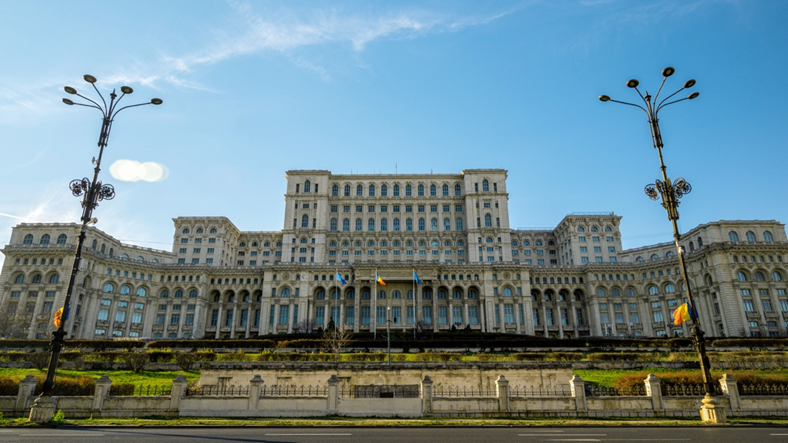On a clear June morning, with a flawless blue sky, Justin and I looked at each other and knew it was finally time to fulfill our long-planned dream: a month-long trip through Romania. There were too many wonderful places I had heard about or seen in pictures. We decided to take a month’s vacation, disconnect from the daily routine and discover all the treasures this country hides. Full of excitement, we rented a compact car, perfect for our adventures, and prepared for an itinerary that promised to take us through historic cities, fairytale mountain landscapes, traditional villages and stunning nature reserves.
Our luggage was packed with light clothes, but also with guide books and detailed maps. Our plan was to avoid the crowded roads and focus on lesser-known routes, letting our curiosity and the locals’ advice guide us. Our first stop was Bucharest, from where we would rent a car and drive to the heart of Transylvania, then to the far north and further west, south and east. We were looking forward to tasting traditional dishes, listening to stories and being overwhelmed by the beauty of the landscapes.
That morning, we got into the car with hearts full of joy and anticipation. With our GPS set and our favorite playlist ready, we hit the road, ready to live the adventure of a lifetime.
Bucharest
Our journey began in Bucharest, a city pulsating with vibrant and contrasting energy. We were greeted by the bustle of the capital, a fascinating mix of modernity and history. Our first stop was the Palace of Parliament, a monumental marble and concrete building that impresses with its size and opulence. Our guide led us through the grand halls, where every architectural detail seemed to tell a story about Romania’s tumultuous past. We were amazed by the grandeur of the building and its complex history, realizing how little we knew about our own country.
After this foray into history, we headed to the Old Center, where the cobblestone streets and ornate facade buildings transported us to another era. Strolling among the bohemian cafes and bistros was a real pleasure. We discovered hidden corners of the city, such as an old bookstore with a mysterious air or a souvenir shop full of handicrafts.
Hunger drove us to Caru’ cu Bere, an emblematic restaurant where we enjoyed traditional dishes. Our menu included ciorbă de belly soup, sarmale, mici and papanași, all served in a cheerful and lively atmosphere. The restaurant’s interior, with its stained-glass windows and wood paneling, added to the charm of our meal. We spent pleasant hours there, enjoying the authentic tastes and live music. In the evening, we retreated to Herăstrău Park, an oasis of greenery and tranquility amid the hustle and bustle of the city. We rented a boat and took a boat trip on the lake, letting the cool breeze pamper us. Around us, families and couples were enjoying nature, and the orange and pink sunset brought us a sense of peace and gratitude.
Brasov
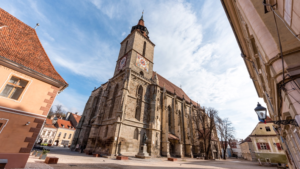
After a day in Bucharest, we set off to Brasov, traveling along the Prahova Valley, a winding road through mountains and picturesque villages. Along the way, we stopped at the Peles Castle in Sinaia, an architectural gem set in a spectacular mountain landscape. The castle, with its graceful towers and ornate facades, introduced us to a royal story. We explored the sumptuous rooms, each decorated with period furnishings and works of art, and listened to the fascinating history of the place from our guide.
Arriving in Brasov, we were greeted by Piața Sfatului, the vibrant center of the medieval city. The colorful buildings and narrow streets enchanted us. We visited the Black Church, a masterpiece of Gothic architecture, which impressed us with its grand dimensions and delicate stained-glass windows. The cool interior and imposing organ gave us a moment of silence and reflection. We climbed up the Tâmpa mountain, using the scenic paths to reach the viewpoint. From there, we admired Brașov, with its red roofs and Gothic towers, enveloped in mountain beauty. In the evening, we indulged in delicious food and mulled wine in a traditional restaurant, where the warm and welcoming atmosphere, with solid wood and a fire in the fireplace, made us feel at home.
Sighisoara
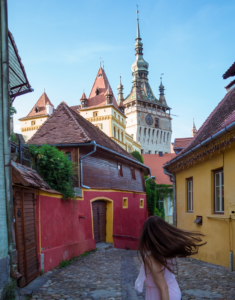
Our journey continued to Sighișoara, the medieval fortress where time seems to stand still. As we drew closer, the imposing silhouette of the fortress rose up the hill, dominating the landscape and promising historical adventures at every turn. Once there, we entered the ancient gates of the fortress and immediately felt transported to another era, one where knights and ladies roamed these streets.
Our first stop was at the Clock Tower, the symbol of the citadel and one of the most impressive examples of medieval architecture in Romania. We ventured up its narrow stairs, each step seeming to take us deeper into history. At the top, we were rewarded with a spectacular panoramic view of the city and its surroundings. We imagined how, centuries ago, the city guards watched from here for any approaching danger. A few steps away, the House of Vlad Tepes (Vlad Dracul) captivated us with its dark and fascinating stories. The interior of the house, transformed into a museum, gave us a glimpse into the life and legends of the voivode. Each room, decorated with period artifacts, seemed to support the mysterious aura of Vlad the Impaler, better known as Dracula. We let our imaginations run wild, envisioning the intrigues and adventures of those distant times.
We continued to explore the narrow streets paved with cubic stone, getting lost in the medieval atmosphere of the city. As we wandered around, every street corner revealed new treasures: an old church hidden between buildings, a flower-filled inner courtyard or a bohemian café with a medieval feel. Sighisoara seemed to be a maze of history, each stone holding stories from long ago. We discovered the covered staircase, a wooden structure that led us to the Church on the Hill. This Gothic church, one of the oldest and best preserved in the region, impressed us with its simplicity and solemnity. The cool and quiet interior offered us a moment of reflection, and the adjacent cemetery, with its ancient and time-bitten tombstones, added a touch of mystery and serenity to our visit.
Every corner of the citadel hid a story, and we eagerly absorbed every detail. We chatted with locals who shared their legends and traditions, visited craft workshops where we admired local art and sampled traditional delicacies from the small bistros and pastry shops in the citadel.
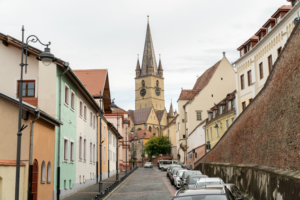
Sibiu greeted us with a special charm, combining the medieval past with the dynamism of the present. We began our exploration at the Brukenthal Museum, located in the Piazza Mare, a baroque palace housing an impressive collection of European and Romanian art. Famous paintings, valuable sculptures and artifacts captivated us, and our guide gave us interesting insights into the museum’s collections and patrons.
We continued our exploration with a visit to the Bridge of Lies, one of Sibiu’s best-known symbols. The legends surrounding this bridge intrigued us and we spent some amusing moments listening to stories about how the bridge would be able to detect the lies of those who cross it. From the Bridge of Lies, we strolled through the Lesser Square and Huet Square, admiring the Gothic and Baroque architecture of the buildings and enjoying the lively and history-filled atmosphere. One of the most memorable experiences in Sibiu was a visit to the Astra Museum in Dumbrava Sibiu. We spent a wonderful day in this open-air museum, which gave us a glimpse into Romanian rural life over the centuries. Traditional houses, wooden churches, water mills and craft workshops gave us a better understanding of how our ancestors lived. Every house and every exhibit seemed to tell a story about long forgotten traditions and customs. We were lucky enough to attend demonstrations of traditional crafts and even participate in interactive activities such as loom-weaving or clay modeling.
Our evenings were spent in the Piazza Mare, where the city lights created a fairytale atmosphere. The beautifully lit historic buildings added a special charm to our evenings. We strolled along the cobbled streets, listening to the music of street performers and savoring local delicacies at the chic terraces. Each evening was a feast for the senses: tastes, sounds and sights that were etched in our memories.
Cluj-Napoca
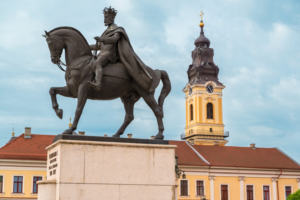
Arriving in Cluj-Napoca, we were captivated by the vibrant life of the university city, a fascinating mix of history, culture and modernity. Cluj greeted us with an effervescent atmosphere, full of young people, chic cafes and cultural events everywhere. The city was pulsating with energy, and we thoroughly enjoyed this contagious vitality.
Our first destination was Union Square, the heart of the city and one of the largest medieval squares in Europe. Here, we were struck by the grandeur of St. Michael’s Cathedral, a Gothic jewel dominating the square with its imposing silhouette. The interior of the cathedral, with its colorful stained-glass windows and impressive frescoes, gave us a moment of quiet contemplation. In front of the cathedral, the equestrian statue of Matei Corvin reminded us of the historical importance of this place and the legends surrounding it. After exploring the Union Square and admiring the elegant architecture of the buildings surrounding it, we headed to the Botanical Garden “Alexandru Borza”. This marvelous place, a true oasis of greenery and tranquility, gave us a welcome break from the hustle and bustle of the city. We strolled along the shady alleys, admired the collections of exotic and native plants, and relaxed by the picturesque lake. The greenhouses, with their tropical climate and rare plants, transported us to other corners of the world, and the Japanese garden, with its arched bridges and lily ponds, offered moments of meditation and serenity.
One of the most impressive experiences in Cluj was the visit to Salina Turda, an amazing place that left us speechless. As we descended into the depths of the earth, we were overwhelmed by the sheer size and beauty of this place. The huge galleries and rooms were enchantingly lit, as if from another realm. Salina Turda, with its underground lake on which we took a boat ride and the panoramic wheel from where we admired the underground landscape, gave us a unique experience. The history of salt mining and the transformation of this mine into an underground amusement park fascinated us and made us appreciate human ingenuity.
In the evening, we returned to the center of Cluj and explored the lively streets with lively restaurants and bars. We enjoyed delicious local and international cuisine and chatted with friendly locals who shared stories about their city. Cluj’s great atmosphere with live music and cultural events captivated us and made us feel part of this dynamic community.
Cluj-Napoca offered us a perfect combination of culture, nature and fun. We left with precious memories and the promise to return to discover other facets of this fascinating city. This leg of our journey through Romania showed us once again how diverse and rich this country is, and reinforced our desire to explore even more of its beauties.
Maramures
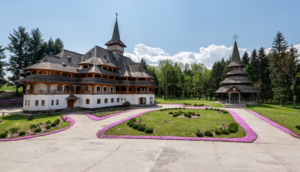
In Maramures, we entered a world of its own, where traditions and customs are preserved with sanctity. The Merry Cemetery in Săpânța impressed us with its unique approach to death. The colorful crosses and humorous epitaphs, painted in a vibrant style, gave us a fascinating insight into the local culture and the community’s celebration of life and death. The fairy-tale village of Breb offered us an authentic rural experience. We were greeted with warm hospitality and took part in traditional activities such as weaving and traditional cooking. We sampled local produce from homemade breads to cheeses and meat dishes. In the evening, we were invited to a traditional horde, where we enjoyed folk dancing and singing.
Maramures left us with priceless memories of traditions and authenticity, and we left with a desire to explore this fascinating region even deeper. Every moment spent here was a lesson in history, culture and the beauty of a place where traditions live in harmony with nature.
Bucovina
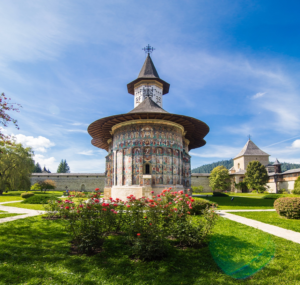
Bucovina welcomed us with a warmth and beauty of its painted monasteries, true treasures of art and spirituality. The entire region is a testament to religious and artistic tradition, and our journey here was a profound and captivating experience.
Our first stop was at the Voroneț Monastery, famous for its unique blue. This “Voronezh Blue” is a deep and vibrant hue, legendary because it cannot be reproduced in its entirety. The exterior frescoes, especially the Last Judgment, are remarkable for their rich detail and the expressiveness of the characters, providing a visually captivating and profound story.
We continued with a visit to Sucevița Monastery, known for its frescoes depicting the “Staircase of Virtues.” These paintings are a visual representation of the struggle between good and evil, bringing to the forefront the complexity of Orthodox spirituality. The vivid colors and intricate details of the frescoes made a deep impression on us, as medieval art has had a considerable impact on our spiritual understanding. Moldovița Monastery gave us a different perspective on religious art. The extremely well-preserved frescoes include biblical and historical scenes, including “The Siege of Constantinople,” an impressive fresco reflecting the importance of historical events in local life. The rich detail of this painting gave us a deeper understanding of the monastery’s historical and artistic context. At Humor Monastery, we were greeted by walls painted in shades of red, offering another dimension of religious art. Frescoes recounting the lives of saints and biblical scenes brought us a special inner peace. The simple and elegant atmosphere of this place gave us an experience of tranquility and reflection.
Bukovinian hospitality was another remarkable aspect of our trip. We were warmly welcomed in traditional houses, savoring traditional dishes such as sarmale, soup from Rovinj, pies and freshly baked cakes, all prepared with local ingredients and following ancient recipes. This culinary experience gave us not only delicious tastes, but also an authentic encounter with the local culture.
Black Sea Coast
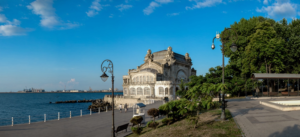
Finally, we headed to the Black Sea coast, where Constanta welcomed us with its marine charm and cosmopolitan atmosphere. After our explorations in more rural and mountainous areas, this destination provided a pleasant contrast. In Constanța, we visited Ovidiu Square, where we admired the statue of the Roman poet Ovid and explored the surrounding historic buildings. The square is a symbol of the historical links between Constanta and the ancient world, offering insight into the city’s importance in the European and Roman historical context.
Constanta’s Casino, with its grand architecture, was another iconic site we explored. The imposing building, located on the seafront, is a symbol of the opulence and refinement of its golden age. The casino’s elaborate detailing impressed us and gave us a glimpse into the lifestyle of yesteryear. The beaches of Constanta were ideal for relaxation and fun. The fine sand and crystal clear water gave us the opportunity to cool off and enjoy the beautiful weather. We enjoyed local cuisine at the waterfront restaurants, tasting fresh seafood and other Romanian delicacies.
The cosmopolitan atmosphere of Constanta brought a perfect end to our journey through Romania. Each region – from the splendor of Bucovina’s monasteries to the charm of the seaside – offered us a unique and memorable experience, ending our adventure in a pleasant and elegant way.
Our 30-day trip through Romania was much more than just a vacation; it was an experience that taught us to appreciate and love this wonderful country even more. Every place we visited added a new thread to our story, every person we met gave us a new perspective and every landscape took our breath away.
We returned home with souls full of precious memories and a new appreciation for Romania’s diversity and cultural richness. We learned to enjoy the simple moments, the hospitality of the people, the authentic tastes and the natural beauty that surrounds us. We realized that the real magic of a journey is not only in the destinations you reach, but in the journey traveled, the experiences lived and the bonds formed.
Looking back on this dream month, we realize how lucky we were to live these moments together. Romania gave us an incredible adventure, one that we will always carry in our hearts. And even though we have returned to our everyday lives, we know that the beauty of this country will always call us back to discover more hidden treasures, to live more unforge
